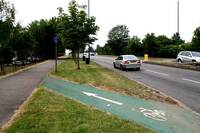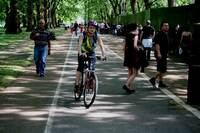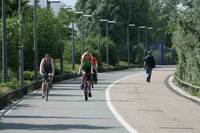- England
- Scotland
- France
- Holland
- Germany
- Italy
- Spain
- Portugal
- USA
- China
- Japan
- India
- Iran
- Advice
- Gardens
- England
- Scotland
- France
- Holland
- Germany
- Italy
- Spain
- Portugal
- USA
- China
- Japan
- India
- Iran
- Advice
- Garden Tours
Book: Landscape Planning and Environmental Impact Design: from EIA to EID
Chapter: Chapter 10 Sustainable green transport
Building upon these exceptions, we can identify a number of different ways of making provision for cyclists: Leisure cyclists should be in close contact with the landscape. A narrow ribbon of macadam can twist, laze and dash through the countryside. For the lone cyclist in unfrequented country, a 300 mm wide strip is adequate - and falling on grass is nicer than falling on Macadam. Twin strips, of the same width but 1.5 metres apart, will cater for larger flows. These strips will allow either for cycling 2-abreast or for cyclists passing in opposite directions. Cyclists can cross the 'central reservation'. In a forest or over a hill, the two paths might diverge, though this would prevent occasional use by farm or forest vehicles, which could improve the financial justification for such a road. Verges and passing places allow still greater volumes - cycling on grass requires more effort but is not unpleasant for short distances. In Britain, Sustrans is having considerable success in making cycle routes. The name is an abbreviation of Sustainable Transport. Sustrans began with the conversion of disused railways lines into cycleways. These have the advantage of being long and straight, with shallow gradients and good bridges, but they are dull as routeways. In many respects, their best use is for commuter traffic. Sustrans also make use of low-volume roads through beautiful scenery. Old roads which have not become heavily used are well suited to the needs of both leisure and commuter cyclists. When the vehicular traffic on an old road exceeds a certain level, a new road should be built on a new alignment. This allows the old road to be made available for low-speed vehicular access and for cycling. If a city wishes to experiment with the construction of a high-volume cycle freeway, it should be started as a shortcut in a location where the volume of cycle traffic is already high. Catering for an existing demand makes better use of resources than building a cycleway to create a demand. Universities are special places for cycle-planning. Students and staff have a much greater propensity to cycle than the general population. Campuses should always be planned with good accommodation for cyclists and with safe routes reaching into the wider community [Fig 10.18]. If flow-volumes are high, cyclists must have real roads, separated from pedestrians by kerbs. Shortcuts have great appeal for cyclists, but they must connect to roads. They save effort, they save time and they give one a pleasant feeling of superiority over the pathetic motorists who waste time and money, bumper-to-bumper, in environmentally-unfriendly queues. Here are some examples of desirable shortcuts: Lightweight bridges over railways, busy roads and busy intersections. Routes across town-centres and residential areas from which motorised through-traffic has been excluded. Paths through parks and greenways. Child-cyclists have special needs, which should be met if they are to grow up with the cycling habit. Below the age of 10, it is unwise for parents to allow children to mix with motor vehicles or fast-moving cyclists. Zones with a special surfacing are desirable, so that parents can say, for example: 'You must stay on the red route'. These safe zones can extend outwards from junior schools and may provide links to shopping, leisure and residential areas. The above points about the character of cycleways may seem obvious to readers, but they are not put into effect by the planners and designers of cycleways. Too often, the cycleway is treated as a child of the road, tagging along beside its parent or sharing its dull characteristics: parallelism, constancy, curbing, junction-waits and a lack of shelter. Off-road 'mountain' cyclists have shown their disdain for these characteristics. Cycleways should be mapped and star-graded for convenience, beauty, safety, gradients and climatic exposure. This would provide useful information for cyclists and display the miserable quality of most designed cycleways.


